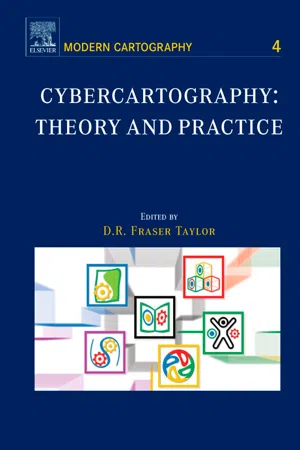
- 594 pages
- English
- PDF
- Available on iOS & Android
About This Book
For generations, the map has been central to how societies function all over the world. Cybercartography is a new paradigm for maps and mapping in the information era. Defined as "the organization, presentation, analysis and communication of spatially referenced information on a wide variety of topics of interest to society, " cybercartography is presented in an interactive, dynamic, multisensory format with the use of multimedia and multimodal interfaces. Cybercartography: Theory and Practice examines the major elements of cybercartography and emphasizes the importance of interaction between theory and practice in developing a paradigm which moves beyond the concept of Geographic Information Systems and Geographical Information Science. It argues for the centrality of the map as part of an integrated information, communication, and analytical package.This volume is a result of a multidisciplinary team effort and has benefited from the input of partners from government, industry and other organizations. The international team reports on major original cybercartographic research and practice from a variety of disciplinary perspectives, including the humanities, social sciences including human factors psychology, cybernetics, English literature, cultural mediation, cartography, and geography. This new synthesis has intrinsic value for industries, the general public, and the relationships between mapping and the development of user-centered multimedia interfaces.* Discusses the centrality of the map and its importance in the information era
* Provides an interdisciplinary approach with contributions from psychology, music, and language and literature
* Describes qualitative and quantitative aspects of cybercartography and the importance of societal context in the interaction between theory and practice
* Contains an interactive CD-Rom containing color images, links to websites, plus other important information to capture the dynamic and interactive elements of cybercartography
Frequently asked questions
Information
Table of contents
- Cover
- Contents
- Preface
- Acknowledgments
- Contributors
- Chapter 01: The Theory and Practice of Cybercartography:An Introduction
- Chapter 02: POMP and Circumstance: Plain Old Map Products in a Cybercartographic World
- Chapter 03: Exploring the Concept of Cybercartography Using the Holonic Tenets of Integral Theory
- Chapter 04: Cybercartography from a Modeling Perspective
- Chapter 05: Cybercartography and Society
- Chapter 06: Technology and Culture in Cybercartography
- Chapter 07: The Cartographer as Mediator: Cartographic Representation from Shared Geographic Information
- Chapter 08: Cybercartography and the New Economy: Collaborative Research in Action
- Chapter 09: Interface Design Challenges in Virtual Space
- Chapter 10: Cognitive Theories and Aids to Support Navigation of Multimedia Information Space
- Chapter 11: Cybercartography: A Multimodal Approach
- Chapter 12: Art, Maps and Cybercartography: Stimulating Reflexivity Among Map-Users
- Chapter 13: Mapping Play: What Cybercartographers can Learn from Popular Culture
- Chapter 14: Linking Geographical Facts with Cartographic Artifacts
- Chapter 15: Pervasive Public Map Displays
- Chapter 16: TeleCartography: A New Means of GeoCommunication
- Chapter 17: Sound Maps: Music and Sound in Cybercartography
- Chapter 18: Interactive Mapping for People Who are Blind or Visually Impaired
- Chapter 19: Exploring Conceptual Landscapes: The Design and Implementation of the Georgia Basin Digital Library
- Chapter 20: The Development of the Cybercartographic Atlas of Antarctica
- Chapter 21: Cybercartography for Education: The Case of the Cybercartographic Atlas of Antarctica
- Chapter 22: Applying a Cybercartographic Human Interface (CHI) Model to Create a Cybercartographic Atlas of Canada’s Trade with the World
- Chapter 23: Remaining Challenges and the Future of Cybercartography
- Subject Index